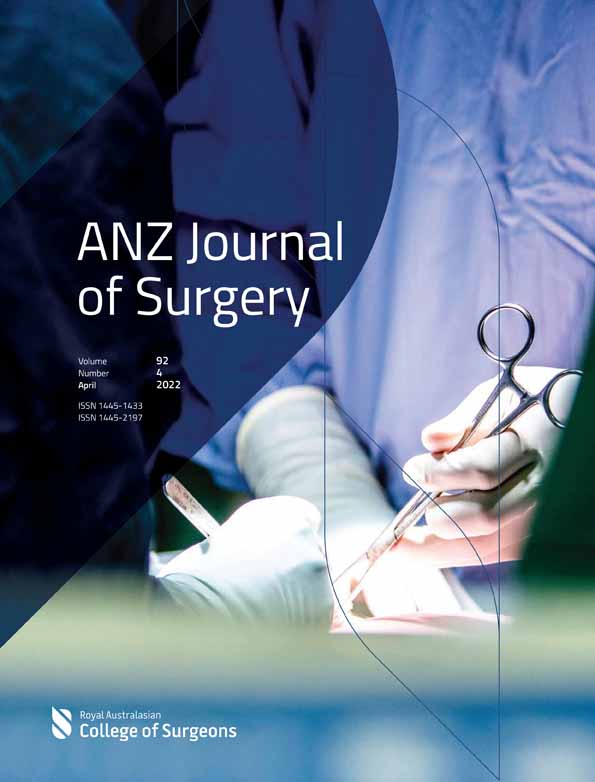Addressing ergonomic, skill acquisition and mentoring constraints that may be contributory to gender disparity in surgery: a ‘value add’ for robotics?
Carrie Fei MBBS
Medical undergraduate, Monash University, Melbourne, Victoria, Australia
Contribution: Methodology
Search for more papers by this authorAlex Karatassas FRACS Ms
University of Adelaide, Masters of minimally invasive surgery course, Department of Surgery Queen Elizabeth Hospital, Adelaide, South Australia, Australia
Contribution: Supervision
Search for more papers by this authorSheryn Cheah FRACS
Surgeon Department, Surgeon, Box Hill Hospital & LapSurgery Australia, Melbourne, Victoria, Australia
Search for more papers by this authorChrys Hensman FRACS Ms
Department of Surgery Monash, University of Melbourne, Melbourne, Victoria, Australia
Department of Robotics, Swinburne University of Technology Melbourne, Melbourne, Victoria, Australia
Department of Surgery, Masters of Minimally Invasive Surgery Course University of Adelaide, Adelaide, South Australia, Australia
Search for more papers by this authorCarrie Fei MBBS
Medical undergraduate, Monash University, Melbourne, Victoria, Australia
Contribution: Methodology
Search for more papers by this authorAlex Karatassas FRACS Ms
University of Adelaide, Masters of minimally invasive surgery course, Department of Surgery Queen Elizabeth Hospital, Adelaide, South Australia, Australia
Contribution: Supervision
Search for more papers by this authorSheryn Cheah FRACS
Surgeon Department, Surgeon, Box Hill Hospital & LapSurgery Australia, Melbourne, Victoria, Australia
Search for more papers by this authorChrys Hensman FRACS Ms
Department of Surgery Monash, University of Melbourne, Melbourne, Victoria, Australia
Department of Robotics, Swinburne University of Technology Melbourne, Melbourne, Victoria, Australia
Department of Surgery, Masters of Minimally Invasive Surgery Course University of Adelaide, Adelaide, South Australia, Australia
Search for more papers by this author
References
- 1Ellison E, Pawlik T, Way D, Satiani B, Williams T. Ten-year reassessment of the shortage of general surgeons: increases in graduation numbers of general surgery residents are insufficient to meet the future demand for general surgeons. Surgery 2018; 164: 726–32.
- 2 Ardnell group. Final report April 2016 - a study exploring the reasons for & experiences of leaving surgical training. Royal Australasian College of Surgeons; 2016, 27.
- 3 Royal Australasian College of Surgeons. Activities report 2020.
- 4Lockhart K, Blatt A. We have cracked the ceiling but how long must we walk on broken glass? Addressing the pitfalls confronting women in surgery. ANZ J. Surg. 2021; 91(9): 1647–9.
- 5Tan R, Bind E, Muir D. Perceived barriers to a career in orthopaedic surgery for women: a comparison between Orthopaedic and general surgery. ANZ J. Surg. 2021; 91(9): 1650–1.
- 6Franasiak J, Ko EM, Kidd J et al. Physical strain and urgent need for ergonomic training among gynecologic oncologists who perform minimally invasive surgery. Gynecol. Oncol. 2012; 126: 437–42.
- 7El Chaar M, King K, Salem J, Arishi A, Galvez A, Stoltzfus J. Robotic surgery results in better outcomes following roux-en-Y gastric bypass: metabolic and bariatric surgery accreditation and quality improvement program analysis for the years 2015–2018. Surg. Obes. Relat. Dis. 2021; 17: 694–700.
- 8Hislop J, Hensman C, Isaksson M, Tirosh O, McCormick J. Self-reported prevalence of injury and discomfort experienced by surgeons performing traditional and robot-assisted laparoscopic surgery: a meta-analysis demonstrating the value of RALS for surgeons. Surg. Endosc. 2020; 34: 4741–53.




